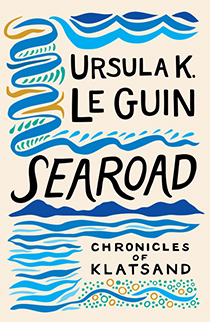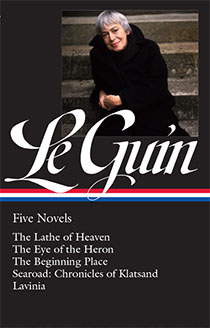From Searoad: Chronicles of Klatsand
Interesting Links
“Ursula K. Le Guin Was a Creator of Worlds” (Julie Phillips, Humanities)
“Heading Home with Author Ursula K. Le Guin” (Watt Childress, Vancouver Observer)
Previous Story of the Week selections
• “Quoits,” Ursula K. Le Guin
• “An Autumn Holiday,” Sarah Orne Jewett
• “Mother,” Sherwood Anderson
• “East Side: North Africa,” Jane Bowles
Buy the book
 Searoad: Chronicles of Klatsand
Searoad: Chronicles of Klatsand
Paperback edition | 256 pages List price: $17.95
Web store price: $14.25
Searoad is also included in:
 Ursula K. Le Guin:
Ursula K. Le Guin:
Five Novels
The Lathe of Heaven | The Eye of the Heron | The Beginning Place | Searoad: Chronicles of Klatsand | Lavinia | 971 pages
“Ursula K. Le Guin Was a Creator of Worlds” (Julie Phillips, Humanities)
“Heading Home with Author Ursula K. Le Guin” (Watt Childress, Vancouver Observer)
Previous Story of the Week selections
• “Quoits,” Ursula K. Le Guin
• “An Autumn Holiday,” Sarah Orne Jewett
• “Mother,” Sherwood Anderson
• “East Side: North Africa,” Jane Bowles
Buy the book
 Searoad: Chronicles of Klatsand
Searoad: Chronicles of KlatsandPaperback edition | 256 pages List price: $17.95
Web store price: $14.25
Searoad is also included in:
 Ursula K. Le Guin:
Ursula K. Le Guin:Five Novels
The Lathe of Heaven | The Eye of the Heron | The Beginning Place | Searoad: Chronicles of Klatsand | Lavinia | 971 pages
 |
| View of the Needles and Haystack Rock from the Oregon Coast Highway, late 1930s. Photograph by postcard manufacturer Wesley Andrews (1875–1950), Portland, Oregon. (eBay) |
Walsh: If you had your voice in the matter, instead of being defined by critics as a science fiction writer, how would you like to be defined?When Le Guin sent Searoad: Chronicles of Klatsand to her publisher, the sales and marketing teams seemed perplexed. “People didn’t know what to do with it,” she recalled. “It didn’t fit any particular category.” The imaginary setting she had used for this suite of stories couldn’t be sold as science fiction, or fantasy, or historical fiction, or children’s literature, or poetry—as was done with each of her previous works. Yet the differences between the “realism” of Searoad and the themes and subjects of Le Guin’s other works may not be as sharp as they initially seem; the ability to invent new places and imaginary communities was what drew Le Guin to science fiction and fantasy in the first place, as she herself often pointed out.
Le Guin: Novelist, short story writer, and poet, because I do write in different forms. Then if they want to say realism, science fiction, fantasy, children’s literature, that’s fine—so long as the terms are used descriptively and not just judgmentally. Yes, I write science fiction. No, I’m not only “a science fiction writer.” Don’t box me in! However, I will get provocative and say I am “a western writer” because we need to redefine that category. Then they say, so you write westerns? and I say no. I am a western writer. I was born in the West and lived most of my life here. I write as a westerner. And I will say yes, I am a woman writer. I finally learned how to say that when I was in my fifties.
Searoad resulted from the purchase of a new house. Le Guin and her husband, Charles, had lived in Portland, Oregon, since 1960, and in the mid-1980s they purchased a summer home in Cannon Beach, a resort community in the state’s northwest corner with a population of about 1,500. The town has enjoyed a reputation as a haven for artists since the 1950s and has remained a destination for vacationers who visit Haystack Rock and the Needles and attend the annual Sandcastle Contest. Over the next half decade, Le Guin wrote the novella and eleven tales that make up Searoad, a “story suite” about moments in the lives of various women (and a few men) living or staying in a resort town. “Searoad was a response to becoming a part-time citizen of a small Oregon coastal town,” she told SF critic Carl Freedman in 2008. “Klatsand is a composite/extract of several towns on the north Oregon coast. The book is exploration, satire, and homage.” Klatsand, with its tiny population of 250, may be fictional, but “between Gearhart and Garibaldi, you’d find it,” she assured Studs Terkel in 1991.
Critics and readers have remarked on the irony that what powers the interconnected stories of Searoad is the missed connections between the characters. “Nobody really connects,” Michael Cadden writes in Ursula K. Le Guin Beyond Genre. “The irony of missed opportunity is more common and almost palpable in this story-suite. Each tale gives us access to the consciousness of one or more characters as a way to reinforce the fact that those in Klatsand share place but not personal space.” Similarly, Dean Flower, in his appraisal of the book for The Hudson Review, commended the collection for its stories portraying “the more isolated and marginal figures of the town, people who are just passing through, or managing a failing business, or hiding from something in the past, holing up emotionally.”
One of those characters is Rosemarie, the owner of a rundown motel called the Ship Ahoy, who anticipates the needs and shortcomings of the guests but avoids interacting with them. Instead, she takes refuge in one of the rooms to read science fiction novels in her downtime. In an analysis of this story, Cadden writes, “It is the feeling, here and throughout, that reaching out beyond a tentative gesture is actually beyond the emotional capabilities of the characters.”
* * *
The White Gull was the really nice motel in town. . . . If you don't see the full selection below, click here (PDF) or click here (Google Docs) to read it—free!This selection is used by permission.
To photocopy and distribute this selection for classroom use, please contact the Copyright Clearance Center.
To photocopy and distribute this selection for classroom use, please contact the Copyright Clearance Center.